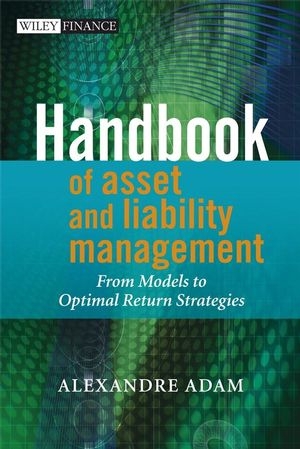
Handbook of Asset and Liability Management
John Wiley & Sons Ltd (Verlag)
978-0-470-03496-5 (ISBN)
- Titel ist leider vergriffen;
keine Neuauflage - Artikel merken
ALEXANDRE ADAM is a French Asset and Liability Manager born in 1973 in Reims, France. He has a Statistician and Economist Post-graduate Diploma of Ecole Nationale de la Statistique et de l'Administration Economique, Malakoff, France. In 1993, he studied Engineering at Ecole Polytechnique, Palaiseau, the major French "Grande Ecole", where he was awarded an Advanced Graduate Degree. Alexandre also has a Masters degree in Mathematics from University Paris-VI. Since 1997, he has worked for BNP Paribas, in the ALM and Treasury Department, initially in charge of the optional interest rate risks in the Balance Sheet before working as a Front Office market operator. Alexandre is now responsible for the Financial Models Team, where his team contributes to the ALM models and indicators such as Stress Tests, economic capital, behavioural models estimation, retail credit risk, implementation and calculation of the Banking Book Value at Risk and Equity Allocation in the Banking Book. Alexandre is an actuary of the French Institute of Actuaries and is a member of the scientific committee of AFGAP, the French Association of Asset and Liability Managers. Since 2005, Alexandre has also been a Master Degree lecturer at University Paris XIII. Alexandre has published many articles on ALM in specialised journals.
Preface. Acknowledgments. About the author. PART I INTRODUCTION. 1 The History of ALM. 1.1 The history of the banking industry from antiquity to the Middle Ages. 1.2 The modern banking industry and the history of ALM. 1.3 The history of the insurance industry and ALM. 1.4 The history of other businesses and ALM. 2 What is Asset and Liability Management Today? 2.1 ALM and the banking industry. 2.2 Other general ALM questions. PART II INTERNAL TRANSFER PRICING, ACCOUNTING AND AUDITING. 3 Balance Sheet Presentation. 3.1 General balance sheet presentation. 3.2 A/L manager's balance sheet presentation. 3.3 Banking Book and Insurance Book. 3.4 Income statement and statement of cash flows. 4 "Accrued Accounting" for Interest Rate Instruments Versus "Marked-to-Market" Accounting. 4.1 General principles. 4.2 Accrued accounting examples. 5 IFRS and IAS Accounting. 5.1 IFRS, international organizations and rule presentation. 5.2 IAS 39. 5.3 Financial disclosures. 5.4 IFRS and insurance. 5.5 Other IFRS specificities. 5.6 Impact of IFRS on ALM and criticism of IFRS. 6 "Economic Accounting": Fair Value and Full Fair Value. 7 Internal Transfer Pricing or Fund Transfer Pricing (FTP). 7.1 Principles. 7.2 Advanced transfer pricings including credit risk and expected return on economic capital. 7.3 The inclusion of implicit options inclusion in the "contract by contract" FTP rules and commercial department arbitrage opportunity. 7.4 FTP rules based on the "stock" and based on the "flows." 7.5 Examples of FTP rules. 7.6 Perequations. 8 ALM as a Profit Centre. 8.1 One profit centre for one financial risk. 9 Optimal Organization of an ALM Team. 9.1 The usual ALM organization. 9.2 The objectives of ALM. 9.3 ALCO: the ALM committee. 9.4 The different ALM teams. PART III BALANCE SHEET ITEMS AND PRODUCTS MODELLING. 10 Behavioural Modelling Principles. 10.1 The constitution of databases. 10.2 Event driven modelling. 10.3 Modelling the strategy of the company. 10.4 Expert advice. 10.5 Model backtesting. 11 Deposits and Savings. 11.1 Deposits, monetary aggregates, money supply and macroeconomics. 11.2 Demand deposit accounts. 11.3 Saving accounts: regulated and non-regulated savings versus super-savings. 11.4 Demand deposits models in the literature. 11.5 Deposit modelling: the solution through an approach based on customer behaviour modelling. 11.6 Deposit modelling through a customer behaviour modelling based approach: representation in risk indicators and FTP. 12 Loans. 12.1 Different types of loan. 12.2 Different definitions and formulae. 13 Prepayments. 13.1 The origins of the prepayment phenomenon. 13.2 The constitution of the database for prepayment modelling. 13.3 Different models: historical database-based approaches and MBS-based approaches. 13.4 Prepayment scoring. 13.5 Prepayment monitoring. 14 Other Examples of Products Needing Behavioural Modelling. 14.1 Pipeline risk. 14.2 Margin delay effects such as "whistle effects" 14.3 Other volume effects options. 15 Examples of Products Partially Correlated with Financial Markets. 15.1 Presence of correlation between the cash flows and financial markets: examples of credit card. 15.2 Costs and commissions correlation with financial markets. 15.3 Examples of embedded options. 16 New Production Modelling. 16.1 New contract production. 16.2 Commission and cost modelling. 16.3 Perequation modelling. 16.4 Future strategies modelling. 17 Insurance Products. 17.1 Unit of account contracts. 17.2 Mutual funds. 18 Hedging Instruments. 18.1 Derivatives. 18.2 Bond strategies. 18.3 Mortgage Backed Securities. PART IV RISK MANAGEMENT FOR ASSET AND LIABILITY MANAGERS. 19 Financial Risks. 19.1 Liquidity risk. 19.2 Credit risk. 19.3 Interest rate risk. 19.4 Inflation risk. 19.5 Currency risk. 19.6 Corporate stock market risk. 19.7 Real estate risk/property risk. 19.8 Other financial risks. 20 Non-Financial Risks. 20.1 Operational risks. 20.2 Model risks. 20.3 Business risk. 20.4 Risk correlations. 20.5 "Accounting risk": the risk representation depends on the accounting scheme! PART V TOOLS FOR ASSET AND LIABILITY MANAGERS. 21 Simulation Tools for Interest Rates and Other Financial Indexes. 21.1 Stochastic calculation. 21.2 Equity market simulation. 21.3 Interest rate simulation. 21.4 Generic models for joint simulation of inflation, stock index, interest rates, real estate, liquidity and credit spreads. 21.5 Market simulations including risk premiums. 22 Delta Equivalent Computation. 22.1 Principles. 22.2 Delta, penta, correla and courba equivalents or "Adam equivalents" 22.3 Delta equivalent associated break-even point. 22.4 Examples of delta equivalent computation. 22.5 Hedging error and gamma equivalent. 23 Technical Tools Useful in ALM. 23.1 Risk measures. 23.2 Optimization methods. 23.3 Common statistical tools in ALM. 23.4 Other statistical tools and common ALM functions. PART VI ECONOMIC VALUE AND NEW RISK INDICATORS ASSOCIATED WITH THE BASEL II AND SOLVENCY II REGULATORY PERSPECTIVE. 24 Basel II Regulation and Solvency II. 24.1 Common regulatory risk constraints. 24.2 Basel II: normalized regulatory constraints. 24.3 Solvency II. 25 Links Between ALM and Financial Analysis. 25.1 Performance indicators in the company. 25.2 Shareholder's equity value, economic value and risk premiums. 25.3 Capital allocation/attribution and capital consumption. 25.4 Company valuation and cost of capital with positive tax rate. 25.5 Merton's model. 25.6 Financial analysis and ALM implications. 26 Towards Economic Capital Indicators. 26.1 Economic capital and its implications. 26.2 Economic capital computation main hypotheses. 26.3 ALM stress testing. 26.4 Credit risk economic capital computation. 26.5 Economic capital in ALM. 26.6 IFRS and regulation implications for ALM. 26.7 New indicators for the economic value approach. PART VII OPTIMAL RETURN STRATEGIES. 27 Risk Perfect Hedging Using the Delta Equivalent Technique. 27.1 Micro hedging strategies with structured products. 27.2 Delta hedging strategies. 27.3 Example of a bank balance sheet with demand deposits. 28 Limits Policy. 28.1 Economic capital limit. 28.2 Setting economic capital limits. 28.3 Gap limit. 28.4 Income sensitivity limit. 29 Income Smoothing Strategies. 29.1 Important preliminary comment about income smoothing and fraud. 29.2 Examples of income smoothing. 29.3 Example of a cumulative AFS bonds income smoothing strategy. 29.4 ALM and Hawks martingale. 30 Economic Value Management: The A/L Manager's Optimization Programme Under Economic Capital Constraints and Accounting Constraints. 30.1 Point of view of "traditional A/L managers" and criticism of the models. 30.2 Economic value management. 30.3 Economic value optimization using grid methodology. 31 Application to Banking Book Activities. 31.1 Deposit accounts: valuation and hedging in an economic capital approach using the grid methodology. 31.2 Application to Stock Market Book. 31.3 Application to Credit Risk Book. 31.4 Prepayment risk optimal hedging strategies. 31.5 Application to a global Banking Book including business and model risk. 31.6 Direct demand deposit income smoothing through a simple example. 32 Economic Value Management in Insurance Companies and in Capital Book Management. 32.1 Economic value management in insurance companies. 32.2 Application to economic Capital Book management. PART VIII CONCLUSIONS ON THE ALM OF TOMORROW. 33 Conclusions on the Future of ALM. 33.1 ALM diversity. 33.2 ALM benchmarking. 33.3 Conclusions on ALM and models. PART IX ANNEXES. 34 Statistical Advanced Tools. 34.1 Extreme points. 34.2 Copulas. 35 The Basis of Interest Rate Modelling. 35.1 Yield curve reconstitution. 35.2 Yield curve stochastic interest rate models. Bibliography. Index.
| Erscheint lt. Verlag | 26.10.2007 |
|---|---|
| Reihe/Serie | Wiley Finance Series |
| Verlagsort | Chichester |
| Sprache | englisch |
| Maße | 175 x 251 mm |
| Gewicht | 1135 g |
| Themenwelt | Wirtschaft ► Betriebswirtschaft / Management ► Finanzierung |
| Betriebswirtschaft / Management ► Spezielle Betriebswirtschaftslehre ► Bankbetriebslehre | |
| ISBN-10 | 0-470-03496-3 / 0470034963 |
| ISBN-13 | 978-0-470-03496-5 / 9780470034965 |
| Zustand | Neuware |
| Haben Sie eine Frage zum Produkt? |
aus dem Bereich


